Natural Food Color Additive Market
Natural Food Color Additive Market Size and Share Forecast Outlook 2025 to 2035
Natural food color additive market is projected to grow from USD 1.9 billion in 2025 to USD 2.9 billion by 2035, at a CAGR of 4.3%. Carotenoids will dominate with a 37.0% market share, while beverages will lead the application segment with a 35.0% share.
Natural Food Color Additive Market Forecast and Outlook 2025 to 2035
The global natural food color additive market is valued at USD 1.9 billion in 2025. It is slated to reach USD 2.9 billion by 2035, recording an absolute increase of USD 1.0 billion over the forecast period. This translates into a total growth of 52.6%, with the market forecast to expand at a compound annual growth rate (CAGR) of 4.3% between 2025 and 2035.
The overall market size is expected to grow by nearly 1.53X during the same period, supported by increasing consumer demand for clean label products, growing awareness of health risks associated with synthetic colors, rising adoption of natural ingredients in food processing, and expanding applications in organic and premium food segments.
Quick Stats for Natural Food Color Additive Market
- Natural Food Color Additive Market Value (2025): USD 1.9 billion
- Natural Food Color Additive Market Forecast Value (2035): USD 2.9 billion
- Natural Food Color Additive Market Forecast CAGR: 4.3%
- Leading Type in Natural Food Color Additive Market: Carotenoids
- Key Growth Regions in Natural Food Color Additive Market: North America, Europe, and Asia-Pacific
- Key Players in Natural Food Color Additive Market: GNT Group, Chr. Hansen, Döhler, Sensient Technologies, DDW The Color House, Kalsec
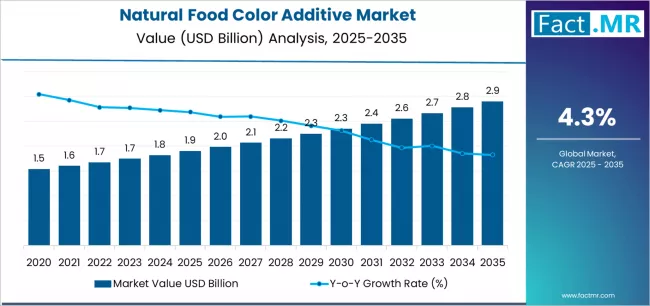
The growth of the natural food color additive market is strongly supported by the global shift toward clean label and health-conscious food consumption. Consumers are increasingly scrutinizing product ingredients, seeking naturally derived colors that do not pose potential health risks associated with synthetic dyes. This trend is prompting food and beverage manufacturers to reformulate products with plant-based and naturally sourced colorants such as anthocyanins, carotenoids, chlorophyll, and betalains. The rising preference for visually appealing, yet safe, food products is particularly pronounced in categories like confectionery, beverages, dairy, bakery, and ready-to-eat meals.
Technological advancements in extraction, stabilization, and encapsulation processes are enhancing the functional performance of natural color additives, improving their heat stability, solubility, and shelf-life. These innovations are enabling manufacturers to maintain product quality and vibrancy even in processed, packaged, or high-temperature applications. Additionally, regulatory support in regions like North America, Europe, and Asia-Pacific, combined with consumer-driven labeling standards, is further encouraging the adoption of natural colorants across both mass-market and premium product lines.
Emerging applications in organic, vegan, and functional foods are providing new growth avenues for market participants. The cosmetic and nutraceutical sectors are also exploring natural color additives for use in herbal supplements, drinks, and skin-friendly edible products. Geographically, Asia-Pacific is poised to witness rapid growth due to rising disposable income, increased awareness of natural and safe ingredients, and expanding food processing industries. Overall, the natural food color additive market is set for sustained expansion, driven by innovation, consumer awareness, and a global commitment to healthier, clean-label alternatives.
Between 2025 and 2030, the natural food color additive market is projected to expand from USD 1.9 billion to USD 2.3 billion, resulting in a value increase of USD 0.4 billion, which represents 40.0% of the total forecast growth for the decade. This phase of development will be shaped by increasing regulatory restrictions on synthetic colors, growing consumer preference for natural ingredients, and expanding applications in functional foods and beverages. Food manufacturers and ingredient suppliers are expanding their natural color capabilities to address the growing demand for clean label and visually appealing food products.
Natural Food Color Additive Market Key Takeaways
| Metric | Value |
|---|---|
| Estimated Value in (2025E) | USD 1.9 billion |
| Forecast Value in (2035F) | USD 2.9 billion |
| Forecast CAGR (2025 to 2035) | 4.3% |
From 2030 to 2035, the market is forecast to grow from USD 2.3 billion to USD 2.9 billion, adding another USD 0.6 billion, which constitutes 60.0% of the overall ten-year expansion. This period is expected to be characterized by the expansion of innovative extraction technologies, development of stable natural color formulations, and growth of personalized nutrition applications requiring specific color profiles. The growing adoption of sustainable food processing and circular economy principles will drive demand for natural food colors with enhanced stability and environmental sustainability credentials.
Between 2020 and 2025, the natural food color additive market experienced accelerated growth, driven by increasing consumer awareness of synthetic color health concerns and growing recognition of natural food colors as safer and more appealing alternatives for food and beverage applications. The market developed as food manufacturers and consumers recognized the potential for natural colors to enhance product appeal, support clean label positioning, and provide health-conscious alternatives while maintaining visual quality and consumer acceptance.
Why is the Natural Food Color Additive Market Growing?
Market expansion is being supported by the increasing consumer demand for clean label and natural food products driven by health consciousness and ingredient transparency preferences, alongside the corresponding need for safe and effective natural coloring solutions that can enhance product appeal, support brand positioning, and provide regulatory compliance across various food, beverage, and confectionery applications.
Modern food manufacturers and ingredient suppliers are increasingly focused on implementing natural color solutions that can replace synthetic alternatives, meet consumer expectations, and provide sustainable and health-conscious ingredient options while maintaining product quality and visual appeal.
The growing emphasis on health and wellness is driving demand for natural food colors that can support clean ingredient lists, enable natural product positioning, and ensure comprehensive safety profiles. Food manufacturers' preference for ingredients that combine visual effectiveness with health benefits and consumer acceptance is creating opportunities for innovative natural color implementations.
The rising influence of organic and premium food trends is also contributing to increased adoption of natural food colors that can provide superior visual enhancement without compromising health consciousness or environmental sustainability.
Segmental Analysis
The market is segmented by type, application, and form. By type, the market is divided into carotenoids, anthocyanins, and chlorophylls/betalains. Based on application, the market is categorized into beverages, confectionery/bakery, and dairy/savory products. By form, the market is segmented into powder and liquid formulations.
By Type, the Carotenoids Segment Leads the Market
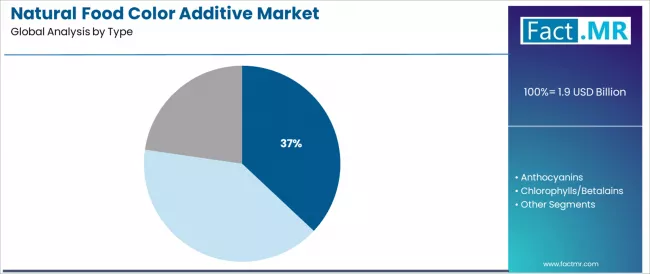
The carotenoids segment is projected to maintain its leading position in the natural food color additive market in 2025 with a 37.0% market share, reaffirming its role as the preferred natural color category for food and beverage applications due to excellent stability and vibrant color properties.
Food manufacturers and ingredient suppliers increasingly utilize carotenoids for their superior heat stability, broad pH tolerance, and proven effectiveness in delivering orange, red, and yellow color profiles while maintaining nutritional benefits and regulatory acceptance.
Carotenoid technology's proven performance and health benefits directly address industry requirements for natural coloring solutions and established consumer acceptance across diverse food categories and processing conditions.
This color segment forms the foundation of natural food coloring, as it represents the type with the greatest contribution to stable color delivery and established market presence across multiple food applications and processing methods. Food industry investments in carotenoid extraction and formulation continue to strengthen adoption among manufacturers and formulators.
With food applications requiring stable and vibrant natural colors, carotenoids align with both performance objectives and health positioning requirements, making them the central component of comprehensive natural color strategies.
By Application, the Beverages Segment Dominates Market Demand
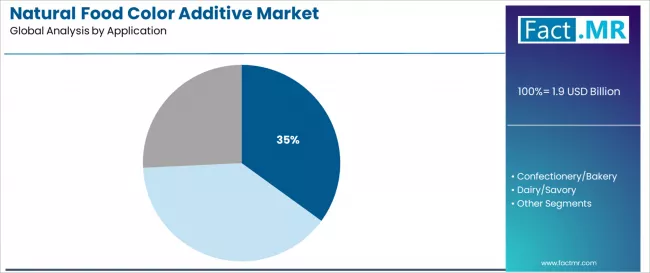
The beverages application segment is projected to represent the largest share of natural food color additive demand in 2025 with a 35.0% market share, underscoring its critical role as the primary driver for natural color adoption across soft drinks, juices, energy drinks, and functional beverages. Beverage manufacturers prefer natural food colors for their ability to enhance visual appeal, support clean label positioning, and provide consumer-preferred ingredients while maintaining product stability and regulatory compliance. Positioned as essential ingredients for beverage differentiation, natural colors offer both visual enhancement advantages and marketing benefits.
The segment is supported by continuous innovation in beverage formulation and the growing availability of water-soluble natural color systems that enable superior color stability with enhanced processing compatibility and shelf-life performance.
Additionally, beverage manufacturers are investing in comprehensive clean label programs to support increasingly sophisticated natural color applications and consumer demand for transparent and natural beverage products. As clean label trends advance and natural ingredient preferences increase, the beverages application will continue to dominate the market while supporting advanced formulation strategies and consumer preference optimization.
What are the Drivers, Restraints, and Key Trends of the Natural Food Color Additive Market?
The natural food color additive market is advancing steadily due to increasing consumer preference for clean label products driven by health consciousness and ingredient transparency trends, alongside growing regulatory restrictions on synthetic food colors that create opportunities for natural alternatives, support market conversion, and enable safer food coloring solutions across various food processing and consumer applications.
However, the market faces challenges, including higher costs compared to synthetic alternatives, stability limitations under certain processing conditions, and limited color palette availability for specific applications. Innovation in extraction technologies and stabilization methods continues to influence product performance and market accessibility patterns.
Expansion of Clean Label and Health-Conscious Trends
The growing consumer demand for clean label and health-conscious food products is driving increased adoption of natural food colors that can support transparent ingredient lists, enhance nutritional positioning, and provide safer alternatives to synthetic coloring agents while maintaining visual appeal and consumer satisfaction.
Food manufacturers require natural color solutions that deliver superior visual performance while supporting health-conscious brand positioning and regulatory compliance across diverse product categories. Companies are increasingly recognizing the competitive advantages of natural color integration for consumer trust and market differentiation, creating opportunities for innovative natural colors designed for health-focused applications and clean label formulations.
Integration of Advanced Extraction and Stabilization Technologies
Modern natural food color manufacturers are incorporating advanced extraction methods and stabilization technologies to enhance color intensity, improve processing stability, and support comprehensive performance objectives through innovative processing techniques, encapsulation systems, and formulation optimization.
Leading companies are developing sustainable extraction processes, implementing stabilization technologies, and advancing color concentration methods that maximize color performance while maintaining natural positioning and cost-effectiveness. These technologies improve product performance while enabling new market opportunities, including heat-stable applications, extended shelf-life products, and challenging processing environments.
Development of Innovative Color Sources and Combinations
The expansion of natural color research and botanical exploration is driving development of novel natural color sources including exotic fruits, vegetables, and plant materials that can provide unique color profiles, enhanced stability, and differentiated market positioning beyond traditional natural color sources.
These innovative color developments require specialized sourcing capabilities and extraction expertise that create unique market segments with differentiated value propositions. Manufacturers are investing in botanical research and color innovation to serve emerging application needs while supporting innovation in natural ingredient diversity and color creativity.
Analysis of the Natural Food Color Additive Market by Key Countries
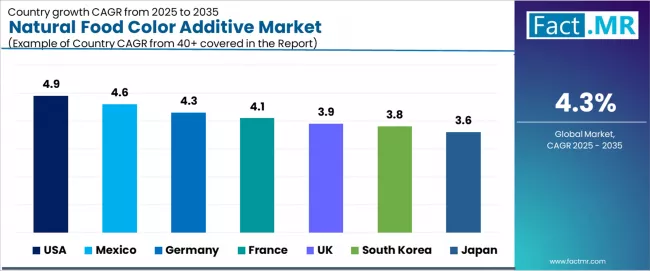
| Country | CAGR (2025-2035) |
|---|---|
| USA | 4.9% |
| Mexico | 4.6% |
| Germany | 4.3% |
| France | 4.1% |
| UK | 3.9% |
| South Korea | 3.8% |
| Japan | 3.6% |
The natural food color additive market is experiencing solid growth globally, with the USA leading at a 4.9% CAGR through 2035, driven by extensive clean label market development, stringent regulatory environment supporting natural alternatives, and strong consumer preference for natural ingredients supporting natural food color adoption. Mexico follows at 4.6%, supported by expanding food processing industry, growing export market requirements, and increasing consumer health consciousness.
Germany shows growth at 4.3%, emphasizing natural ingredient quality, regulatory leadership, and comprehensive clean label trends. France demonstrates 4.1% growth, supported by food culture sophistication, premium product focus, and natural ingredient appreciation.
The UK records 3.9%, focusing on clean label requirements, health-conscious consumption, and natural ingredient preferences. South Korea exhibits 3.8% growth, emphasizing food safety consciousness and premium natural ingredients. Japan shows 3.6% growth, supported by quality food culture and natural ingredient standards.
USA Leads Global Market Growth with Clean Label Innovation
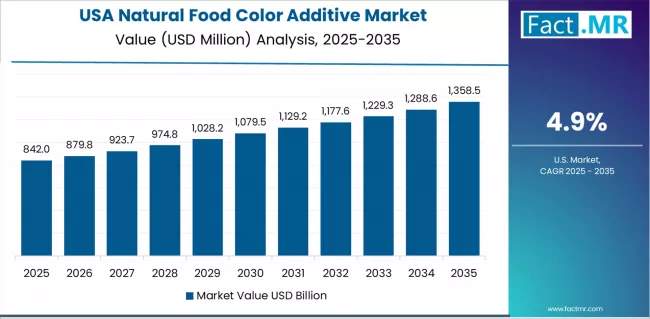
Revenue from natural food color additives in the USA is projected to exhibit strong growth with a CAGR of 4.9% through 2035, driven by extensive clean label market development and stringent regulatory environment supporting natural food color adoption among food manufacturers, beverage companies, and ingredient suppliers.
The country's established natural products infrastructure and increasing consumer demand for transparent ingredients are creating substantial demand for natural color solutions. Major food manufacturers and ingredient companies are establishing comprehensive natural color programs to serve both domestic markets and clean label requirements.
- Strong clean label market development and regulatory support for natural alternatives are driving demand for natural food colors throughout food manufacturers, beverage producers, and ingredient suppliers across innovation centers, processing facilities, and retail channels.
- Growing consumer preference for transparent ingredients and health-conscious food choices are supporting the rapid adoption of natural food colors among companies seeking product differentiation, consumer trust, and regulatory compliance for diverse food and beverage applications.
Mexico Demonstrates Strong Market Potential with Processing Industry Expansion
Revenue from natural food color additives in Mexico is expanding at a CAGR of 4.6%, supported by the country's expanding food processing industry, growing export market requirements, and increasing consumer health consciousness driving natural ingredient adoption for both domestic and international market applications.
The country's evolving food industry capabilities and quality standards are driving demand for natural color ingredients throughout diverse food processing sectors. Leading food processors and ingredient suppliers are establishing comprehensive natural color capabilities to address growing domestic and export market requirements.
- Rising food processing sophistication and expanding export market focus are creating opportunities for natural food color adoption across food manufacturers, beverage producers, and processing facilities in major industrial regions and export-oriented processing centers.
- Growing consumer health consciousness and quality enhancement initiatives are driving adoption of natural color ingredients among manufacturers seeking enhanced product appeal and market competitiveness for Mexican food and beverage products in domestic and international markets.
Germany Demonstrates Quality Excellence with Natural Innovation Leadership
Revenue from natural food color additives in Germany is expanding at a CAGR of 4.3%, driven by the country's emphasis on natural ingredient quality, regulatory leadership in food safety, and comprehensive clean label market development supporting innovative natural food color adoption.
Germany's food technology excellence and regulatory sophistication are driving demand for high-quality natural color solutions. Leading food technology and ingredient companies are establishing comprehensive innovation programs for next-generation natural coloring solutions.
- Advanced food technology standards and natural ingredient focus are creating demand for premium natural food colors among food manufacturers seeking enhanced quality credentials and sustainable ingredient solutions.
- Strong regulatory leadership and clean label market development are supporting the adoption of innovative natural color technologies across food processing facilities, ingredient suppliers, and quality-focused manufacturers throughout major food industry regions.
France Focuses on Culinary Excellence and Premium Natural Ingredients
Revenue from natural food color additives in France is expanding at a CAGR of 4.1%, driven by the country's food culture sophistication, premium product focus, and comprehensive approach to natural ingredient utilization supporting natural food color integration into French food manufacturing and culinary applications.
France's culinary heritage and premium food positioning are supporting investment in natural color technologies. Major food companies and culinary ingredient suppliers are establishing comprehensive innovation programs incorporating natural colors with French food excellence.
- Advanced culinary culture and premium food focus are creating demand for natural food colors throughout premium food manufacturers, gourmet ingredient suppliers, and culinary application centers serving quality-focused market segments.
- Strong food culture sophistication and natural ingredient appreciation are driving the adoption of premium natural color solutions across gourmet food production, premium retail channels, and sophisticated culinary applications throughout major culinary and food manufacturing regions.
UK Shows Market Leadership with Clean Label Requirements
Revenue from natural food color additives in the UK is expanding at a CAGR of 3.9%, supported by the country's clean label requirements, health-conscious consumption trends, and comprehensive natural ingredient preferences supporting natural food color utilization across diverse food manufacturing and consumer applications.
The UK's food market sophistication and health consciousness are driving demand for natural color solutions. Leading food manufacturers and ingredient suppliers are investing in natural color development and clean label positioning for health-conscious consumers.
- Advanced clean label requirements and health-conscious consumption trends are creating opportunities for natural food colors throughout food manufacturers, ingredient suppliers, and retail channels serving natural product-focused consumer segments.
- Strong natural ingredient preferences and food safety consciousness are driving the adoption of natural food colors across clean label formulations, health-focused products, and natural ingredient-oriented manufacturing targeting quality-conscious consumers.
South Korea Demonstrates Innovation Leadership with Food Safety Focus
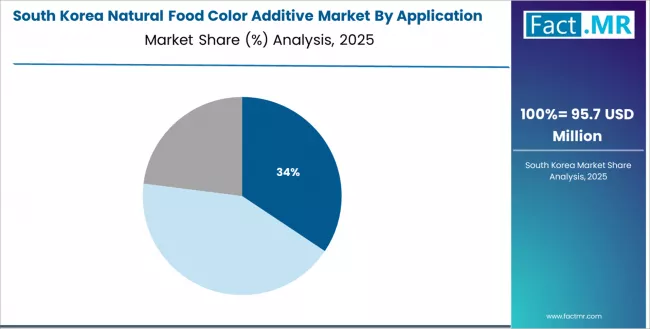
Revenue from natural food color additives in South Korea is expanding at a CAGR of 3.8%, supported by the country's food safety consciousness, premium natural ingredient preferences, and growing emphasis on quality food production and consumer health supporting advanced natural food color adoption.
The nation's food quality standards and health consciousness are driving demand for premium natural color solutions. Leading food companies are investing extensively in natural ingredient development and food safety market positioning.
- Advanced food safety consciousness and premium ingredient focus are creating demand for natural food colors throughout food manufacturers, premium ingredient suppliers, and quality-focused food production facilities.
- Strong health consciousness and quality food production emphasis are supporting the adoption of natural food colors designed for food safety enhancement, premium product positioning, and comprehensive health-conscious food manufacturing across diverse food categories and consumer segments.
Japan Shows Premium Focus with Quality Natural Standards
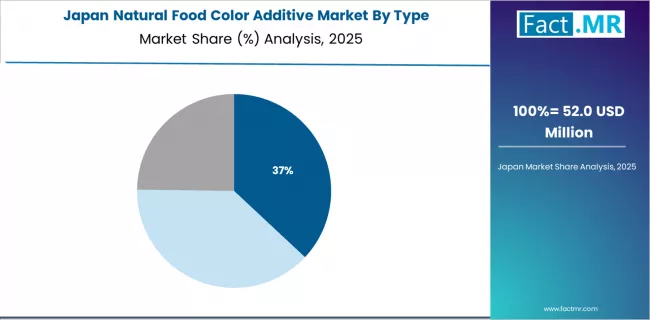
Revenue from natural food color additives in Japan is expanding at a CAGR of 3.6%, supported by the country's quality food culture, natural ingredient standards, and strong emphasis on authentic natural products and food safety supporting natural food color adoption for premium food applications.
Japan's quality consciousness and natural product appreciation are driving demand for premium natural color products. Leading food and ingredient companies are investing in specialized capabilities for quality natural color applications and authentic food production.
- Advanced quality food culture and natural ingredient standards are creating opportunities for natural food colors throughout premium food manufacturers, quality ingredient suppliers, and authentic food production facilities serving discerning consumer segments.
- Strong natural product appreciation and food safety focus are driving adoption of premium natural food colors meeting Japanese expectations for quality assurance, natural authenticity, and comprehensive food safety across diverse premium food applications.
Europe Market Split by Country
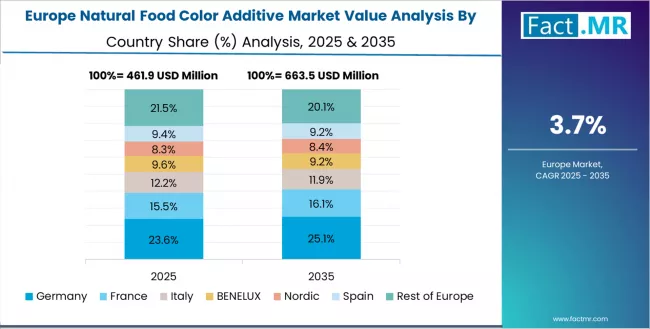
The natural food color additive market in Europe is projected to grow from USD 620.0 million in 2025 to USD 925.0 million by 2035, registering a CAGR of 4.1% over the forecast period. Germany is expected to maintain leadership with a 28.7% market share in 2025, moderating to 28.4% by 2035, supported by natural ingredient quality emphasis, regulatory leadership, and comprehensive clean label market development.
France follows with 24.2% in 2025, projected to reach 24.5% by 2035, driven by food culture sophistication, premium product focus, and natural ingredient appreciation supporting color innovation. The United Kingdom holds 21.0% in 2025, expected to reach 21.2% by 2035 due to clean label requirements and health-conscious consumption trends. Italy commands 15.3% in 2025, rising to 15.4% by 2035, while Spain accounts for 7.4% in 2025, reaching 7.5% by 2035. The Rest of Europe region is anticipated to hold 3.4% in 2025 and 3.0% by 2035, reflecting steady natural ingredient market development in Nordic countries and emerging clean label markets in Eastern European countries.
Competitive Landscape of the Natural Food Color Additive Market
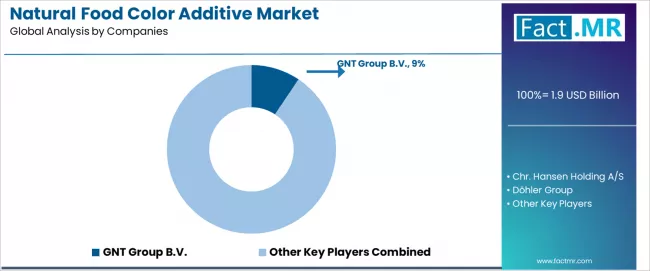
The natural food color additive market is characterized by competition among established ingredient suppliers, specialized natural color manufacturers, and food technology companies. Companies are investing in extraction technology development, stabilization research, sustainable sourcing programs, and application development to deliver effective, stable, and cost-competitive natural food color solutions. Innovation in color extraction, stability enhancement, and application optimization is central to strengthening market position and competitive advantage.
GNT Group leads the market with a 9.4% share, offering comprehensive natural food color solutions with focus on vegetable-based colors, sustainable production methods, and extensive application expertise across diverse food and beverage applications. The company continues investing in sustainable sourcing, extraction technology, and application development while expanding global production capabilities and technical service networks.
Chr. Hansen provides natural ingredient solutions with emphasis on microbial and plant-based colors. Döhler specializes in natural ingredient systems and color applications. Sensient Technologies focuses on advanced color technology and stability solutions. DDW The Color House emphasizes caramel colors and natural alternatives. Kalsec offers natural preservation and color solutions.
Key Players in the Natural Food Color Additive Market
- GNT Group B.V.
- Chr. Hansen Holding A/S
- Döhler Group
- Sensient Technologies Corporation
- DDW The Color House, Inc.
- Kalsec, Inc.
- Naturex (Groupe Roullier brand)
- Symrise AG
- Kancor Ingredients Limited
- Archer Daniels Midland Company (ADM)
Scope of the Report
| Items | Values |
|---|---|
| Quantitative Units (2025) | USD 1.9 Billion |
| Type | Carotenoids, Anthocyanins, Chlorophylls/Betalains |
| Application | Beverages, Confectionery/Bakery, Dairy/Savory |
| Form | Powder, Liquid |
| Regions Covered | North America, Europe, Asia-Pacific, Latin America, Middle East & Africa |
| Countries Covered | USA, Mexico, Germany, France, UK, Japan, South Korea, and 40+ countries |
| Key Companies Profiled | GNT Group, Chr. Hansen, Döhler, Sensient Technologies, DDW The Color House, Kalsec |
| Additional Attributes | Dollar sales by type and application, regional demand trends, competitive landscape, extraction technology advancement, stability enhancement research, sustainable sourcing development, and clean label innovation optimization |
Natural Food Color Additive Market by Segments
-
Type :
- Carotenoids
- Anthocyanins
- Chlorophylls/Betalains
-
Application :
- Beverages
- Confectionery/Bakery
- Dairy/Savory
-
Form :
- Powder
- Liquid
-
Region :
-
North America
- United States
- Canada
- Mexico
-
Europe
- Germany
- United Kingdom
- France
- Italy
- Spain
- Netherlands
- Rest of Europe
-
Asia-Pacific
- Japan
- South Korea
- China
- India
- Australia
- Rest of Asia-Pacific
-
Latin America
- Brazil
- Argentina
- Rest of Latin America
-
Middle East & Africa
- Kingdom of Saudi Arabia
- South Africa
- Rest of Middle East & Africa
-
Table of Content
- Executive Summary
- Global Market Outlook
- Demand to side Trends
- Supply to side Trends
- Technology Roadmap Analysis
- Analysis and Recommendations
- Market Overview
- Market Coverage / Taxonomy
- Market Definition / Scope / Limitations
- Market Background
- Market Dynamics
- Drivers
- Restraints
- Opportunity
- Trends
- Scenario Forecast
- Demand in Optimistic Scenario
- Demand in Likely Scenario
- Demand in Conservative Scenario
- Opportunity Map Analysis
- Product Life Cycle Analysis
- Supply Chain Analysis
- Investment Feasibility Matrix
- Value Chain Analysis
- PESTLE and Porter’s Analysis
- Regulatory Landscape
- Regional Parent Market Outlook
- Production and Consumption Statistics
- Import and Export Statistics
- Market Dynamics
- Global Market Analysis 2020 to 2024 and Forecast, 2025 to 2035
- Historical Market Size Value (USD Million) Analysis, 2020 to 2024
- Current and Future Market Size Value (USD Million) Projections, 2025 to 2035
- Y to o to Y Growth Trend Analysis
- Absolute $ Opportunity Analysis
- Global Market Pricing Analysis 2020 to 2024 and Forecast 2025 to 2035
- Global Market Analysis 2020 to 2024 and Forecast 2025 to 2035, By Type
- Introduction / Key Findings
- Historical Market Size Value (USD Million) Analysis By Type , 2020 to 2024
- Current and Future Market Size Value (USD Million) Analysis and Forecast By Type , 2025 to 2035
- Carotenoids
- Anthocyanins
- Chlorophylls/Betalains
- Y to o to Y Growth Trend Analysis By Type , 2020 to 2024
- Absolute $ Opportunity Analysis By Type , 2025 to 2035
- Global Market Analysis 2020 to 2024 and Forecast 2025 to 2035, By Application
- Introduction / Key Findings
- Historical Market Size Value (USD Million) Analysis By Application, 2020 to 2024
- Current and Future Market Size Value (USD Million) Analysis and Forecast By Application, 2025 to 2035
- Beverages
- Confectionery/Bakery
- Dairy/Savory
- Y to o to Y Growth Trend Analysis By Application, 2020 to 2024
- Absolute $ Opportunity Analysis By Application, 2025 to 2035
- Global Market Analysis 2020 to 2024 and Forecast 2025 to 2035, By Region
- Introduction
- Historical Market Size Value (USD Million) Analysis By Region, 2020 to 2024
- Current Market Size Value (USD Million) Analysis and Forecast By Region, 2025 to 2035
- North America
- Latin America
- Western Europe
- Eastern Europe
- East Asia
- South Asia and Pacific
- Middle East & Africa
- Market Attractiveness Analysis By Region
- North America Market Analysis 2020 to 2024 and Forecast 2025 to 2035, By Country
- Historical Market Size Value (USD Million) Trend Analysis By Market Taxonomy, 2020 to 2024
- Market Size Value (USD Million) Forecast By Market Taxonomy, 2025 to 2035
- By Country
- USA
- Canada
- Mexico
- By Type
- By Application
- By Country
- Market Attractiveness Analysis
- By Country
- By Type
- By Application
- Key Takeaways
- Latin America Market Analysis 2020 to 2024 and Forecast 2025 to 2035, By Country
- Historical Market Size Value (USD Million) Trend Analysis By Market Taxonomy, 2020 to 2024
- Market Size Value (USD Million) Forecast By Market Taxonomy, 2025 to 2035
- By Country
- Brazil
- Chile
- Rest of Latin America
- By Type
- By Application
- By Country
- Market Attractiveness Analysis
- By Country
- By Type
- By Application
- Key Takeaways
- Western Europe Market Analysis 2020 to 2024 and Forecast 2025 to 2035, By Country
- Historical Market Size Value (USD Million) Trend Analysis By Market Taxonomy, 2020 to 2024
- Market Size Value (USD Million) Forecast By Market Taxonomy, 2025 to 2035
- By Country
- Germany
- UK
- Italy
- Spain
- France
- Nordic
- BENELUX
- Rest of Western Europe
- By Type
- By Application
- By Country
- Market Attractiveness Analysis
- By Country
- By Type
- By Application
- Key Takeaways
- Eastern Europe Market Analysis 2020 to 2024 and Forecast 2025 to 2035, By Country
- Historical Market Size Value (USD Million) Trend Analysis By Market Taxonomy, 2020 to 2024
- Market Size Value (USD Million) Forecast By Market Taxonomy, 2025 to 2035
- By Country
- Russia
- Poland
- Hungary
- Balkan & Baltic
- Rest of Eastern Europe
- By Type
- By Application
- By Country
- Market Attractiveness Analysis
- By Country
- By Type
- By Application
- Key Takeaways
- East Asia Market Analysis 2020 to 2024 and Forecast 2025 to 2035, By Country
- Historical Market Size Value (USD Million) Trend Analysis By Market Taxonomy, 2020 to 2024
- Market Size Value (USD Million) Forecast By Market Taxonomy, 2025 to 2035
- By Country
- China
- Japan
- South Korea
- By Type
- By Application
- By Country
- Market Attractiveness Analysis
- By Country
- By Type
- By Application
- Key Takeaways
- South Asia and Pacific Market Analysis 2020 to 2024 and Forecast 2025 to 2035, By Country
- Historical Market Size Value (USD Million) Trend Analysis By Market Taxonomy, 2020 to 2024
- Market Size Value (USD Million) Forecast By Market Taxonomy, 2025 to 2035
- By Country
- India
- ASEAN
- Australia & New Zealand
- Rest of South Asia and Pacific
- By Type
- By Application
- By Country
- Market Attractiveness Analysis
- By Country
- By Type
- By Application
- Key Takeaways
- Middle East & Africa Market Analysis 2020 to 2024 and Forecast 2025 to 2035, By Country
- Historical Market Size Value (USD Million) Trend Analysis By Market Taxonomy, 2020 to 2024
- Market Size Value (USD Million) Forecast By Market Taxonomy, 2025 to 2035
- By Country
- Kingdom of Saudi Arabia
- Other GCC Countries
- Turkiye
- South Africa
- Other African Union
- Rest of Middle East & Africa
- By Type
- By Application
- By Country
- Market Attractiveness Analysis
- By Country
- By Type
- By Application
- Key Takeaways
- Key Countries Market Analysis
- USA
- Pricing Analysis
- Market Share Analysis, 2024
- By Type
- By Application
- Canada
- Pricing Analysis
- Market Share Analysis, 2024
- By Type
- By Application
- Mexico
- Pricing Analysis
- Market Share Analysis, 2024
- By Type
- By Application
- Brazil
- Pricing Analysis
- Market Share Analysis, 2024
- By Type
- By Application
- Chile
- Pricing Analysis
- Market Share Analysis, 2024
- By Type
- By Application
- Germany
- Pricing Analysis
- Market Share Analysis, 2024
- By Type
- By Application
- UK
- Pricing Analysis
- Market Share Analysis, 2024
- By Type
- By Application
- Italy
- Pricing Analysis
- Market Share Analysis, 2024
- By Type
- By Application
- Spain
- Pricing Analysis
- Market Share Analysis, 2024
- By Type
- By Application
- France
- Pricing Analysis
- Market Share Analysis, 2024
- By Type
- By Application
- India
- Pricing Analysis
- Market Share Analysis, 2024
- By Type
- By Application
- ASEAN
- Pricing Analysis
- Market Share Analysis, 2024
- By Type
- By Application
- Australia & New Zealand
- Pricing Analysis
- Market Share Analysis, 2024
- By Type
- By Application
- China
- Pricing Analysis
- Market Share Analysis, 2024
- By Type
- By Application
- Japan
- Pricing Analysis
- Market Share Analysis, 2024
- By Type
- By Application
- South Korea
- Pricing Analysis
- Market Share Analysis, 2024
- By Type
- By Application
- Russia
- Pricing Analysis
- Market Share Analysis, 2024
- By Type
- By Application
- Poland
- Pricing Analysis
- Market Share Analysis, 2024
- By Type
- By Application
- Hungary
- Pricing Analysis
- Market Share Analysis, 2024
- By Type
- By Application
- Kingdom of Saudi Arabia
- Pricing Analysis
- Market Share Analysis, 2024
- By Type
- By Application
- Turkiye
- Pricing Analysis
- Market Share Analysis, 2024
- By Type
- By Application
- South Africa
- Pricing Analysis
- Market Share Analysis, 2024
- By Type
- By Application
- USA
- Market Structure Analysis
- Competition Dashboard
- Competition Benchmarking
- Market Share Analysis of Top Players
- By Regional
- By Type
- By Application
- Competition Analysis
- Competition Deep Dive
- GNT Group B.V.
- Overview
- Product Portfolio
- Profitability by Market Segments (Product/Age /Sales Channel/Region)
- Sales Footprint
- Strategy Overview
- Marketing Strategy
- Product Strategy
- Channel Strategy
- Chr. Hansen Holding A/S
- Döhler Group
- Sensient Technologies Corporation
- DDW The Color House, Inc.
- Kalsec, Inc.
- Naturex (Groupe Roullier brand)
- Symrise AG
- Kancor Ingredients Limited
- Archer Daniels Midland Company (ADM)
- GNT Group B.V.
- Competition Deep Dive
- Assumptions & Acronyms Used
- Research Methodology
List Of Table
- Table 1: Global Market Value (USD Million) Forecast by Region, 2020 to 2035
- Table 2: Global Market Value (USD Million) Forecast by Type , 2020 to 2035
- Table 3: Global Market Value (USD Million) Forecast by Application, 2020 to 2035
- Table 4: North America Market Value (USD Million) Forecast by Country, 2020 to 2035
- Table 5: North America Market Value (USD Million) Forecast by Type , 2020 to 2035
- Table 6: North America Market Value (USD Million) Forecast by Application, 2020 to 2035
- Table 7: Latin America Market Value (USD Million) Forecast by Country, 2020 to 2035
- Table 8: Latin America Market Value (USD Million) Forecast by Type , 2020 to 2035
- Table 9: Latin America Market Value (USD Million) Forecast by Application, 2020 to 2035
- Table 10: Western Europe Market Value (USD Million) Forecast by Country, 2020 to 2035
- Table 11: Western Europe Market Value (USD Million) Forecast by Type , 2020 to 2035
- Table 12: Western Europe Market Value (USD Million) Forecast by Application, 2020 to 2035
- Table 13: Eastern Europe Market Value (USD Million) Forecast by Country, 2020 to 2035
- Table 14: Eastern Europe Market Value (USD Million) Forecast by Type , 2020 to 2035
- Table 15: Eastern Europe Market Value (USD Million) Forecast by Application, 2020 to 2035
- Table 16: East Asia Market Value (USD Million) Forecast by Country, 2020 to 2035
- Table 17: East Asia Market Value (USD Million) Forecast by Type , 2020 to 2035
- Table 18: East Asia Market Value (USD Million) Forecast by Application, 2020 to 2035
- Table 19: South Asia and Pacific Market Value (USD Million) Forecast by Country, 2020 to 2035
- Table 20: South Asia and Pacific Market Value (USD Million) Forecast by Type , 2020 to 2035
- Table 21: South Asia and Pacific Market Value (USD Million) Forecast by Application, 2020 to 2035
- Table 22: Middle East & Africa Market Value (USD Million) Forecast by Country, 2020 to 2035
- Table 23: Middle East & Africa Market Value (USD Million) Forecast by Type , 2020 to 2035
- Table 24: Middle East & Africa Market Value (USD Million) Forecast by Application, 2020 to 2035
List Of Figures
- Figure 1: Global Market Pricing Analysis
- Figure 2: Global Market Value (USD Million) Forecast 2020-2035
- Figure 3: Global Market Value Share and BPS Analysis by Type , 2025 and 2035
- Figure 4: Global Market Y to o to Y Growth Comparison by Type , 2025-2035
- Figure 5: Global Market Attractiveness Analysis by Type
- Figure 6: Global Market Value Share and BPS Analysis by Application, 2025 and 2035
- Figure 7: Global Market Y to o to Y Growth Comparison by Application, 2025-2035
- Figure 8: Global Market Attractiveness Analysis by Application
- Figure 9: Global Market Value (USD Million) Share and BPS Analysis by Region, 2025 and 2035
- Figure 10: Global Market Y to o to Y Growth Comparison by Region, 2025-2035
- Figure 11: Global Market Attractiveness Analysis by Region
- Figure 12: North America Market Incremental Dollar Opportunity, 2025-2035
- Figure 13: Latin America Market Incremental Dollar Opportunity, 2025-2035
- Figure 14: Western Europe Market Incremental Dollar Opportunity, 2025-2035
- Figure 15: Eastern Europe Market Incremental Dollar Opportunity, 2025-2035
- Figure 16: East Asia Market Incremental Dollar Opportunity, 2025-2035
- Figure 17: South Asia and Pacific Market Incremental Dollar Opportunity, 2025-2035
- Figure 18: Middle East & Africa Market Incremental Dollar Opportunity, 2025-2035
- Figure 19: North America Market Value Share and BPS Analysis by Country, 2025 and 2035
- Figure 20: North America Market Value Share and BPS Analysis by Type , 2025 and 2035
- Figure 21: North America Market Y to o to Y Growth Comparison by Type , 2025-2035
- Figure 22: North America Market Attractiveness Analysis by Type
- Figure 23: North America Market Value Share and BPS Analysis by Application, 2025 and 2035
- Figure 24: North America Market Y to o to Y Growth Comparison by Application, 2025-2035
- Figure 25: North America Market Attractiveness Analysis by Application
- Figure 26: Latin America Market Value Share and BPS Analysis by Country, 2025 and 2035
- Figure 27: Latin America Market Value Share and BPS Analysis by Type , 2025 and 2035
- Figure 28: Latin America Market Y to o to Y Growth Comparison by Type , 2025-2035
- Figure 29: Latin America Market Attractiveness Analysis by Type
- Figure 30: Latin America Market Value Share and BPS Analysis by Application, 2025 and 2035
- Figure 31: Latin America Market Y to o to Y Growth Comparison by Application, 2025-2035
- Figure 32: Latin America Market Attractiveness Analysis by Application
- Figure 33: Western Europe Market Value Share and BPS Analysis by Country, 2025 and 2035
- Figure 34: Western Europe Market Value Share and BPS Analysis by Type , 2025 and 2035
- Figure 35: Western Europe Market Y to o to Y Growth Comparison by Type , 2025-2035
- Figure 36: Western Europe Market Attractiveness Analysis by Type
- Figure 37: Western Europe Market Value Share and BPS Analysis by Application, 2025 and 2035
- Figure 38: Western Europe Market Y to o to Y Growth Comparison by Application, 2025-2035
- Figure 39: Western Europe Market Attractiveness Analysis by Application
- Figure 40: Eastern Europe Market Value Share and BPS Analysis by Country, 2025 and 2035
- Figure 41: Eastern Europe Market Value Share and BPS Analysis by Type , 2025 and 2035
- Figure 42: Eastern Europe Market Y to o to Y Growth Comparison by Type , 2025-2035
- Figure 43: Eastern Europe Market Attractiveness Analysis by Type
- Figure 44: Eastern Europe Market Value Share and BPS Analysis by Application, 2025 and 2035
- Figure 45: Eastern Europe Market Y to o to Y Growth Comparison by Application, 2025-2035
- Figure 46: Eastern Europe Market Attractiveness Analysis by Application
- Figure 47: East Asia Market Value Share and BPS Analysis by Country, 2025 and 2035
- Figure 48: East Asia Market Value Share and BPS Analysis by Type , 2025 and 2035
- Figure 49: East Asia Market Y to o to Y Growth Comparison by Type , 2025-2035
- Figure 50: East Asia Market Attractiveness Analysis by Type
- Figure 51: East Asia Market Value Share and BPS Analysis by Application, 2025 and 2035
- Figure 52: East Asia Market Y to o to Y Growth Comparison by Application, 2025-2035
- Figure 53: East Asia Market Attractiveness Analysis by Application
- Figure 54: South Asia and Pacific Market Value Share and BPS Analysis by Country, 2025 and 2035
- Figure 55: South Asia and Pacific Market Value Share and BPS Analysis by Type , 2025 and 2035
- Figure 56: South Asia and Pacific Market Y to o to Y Growth Comparison by Type , 2025-2035
- Figure 57: South Asia and Pacific Market Attractiveness Analysis by Type
- Figure 58: South Asia and Pacific Market Value Share and BPS Analysis by Application, 2025 and 2035
- Figure 59: South Asia and Pacific Market Y to o to Y Growth Comparison by Application, 2025-2035
- Figure 60: South Asia and Pacific Market Attractiveness Analysis by Application
- Figure 61: Middle East & Africa Market Value Share and BPS Analysis by Country, 2025 and 2035
- Figure 62: Middle East & Africa Market Value Share and BPS Analysis by Type , 2025 and 2035
- Figure 63: Middle East & Africa Market Y to o to Y Growth Comparison by Type , 2025-2035
- Figure 64: Middle East & Africa Market Attractiveness Analysis by Type
- Figure 65: Middle East & Africa Market Value Share and BPS Analysis by Application, 2025 and 2035
- Figure 66: Middle East & Africa Market Y to o to Y Growth Comparison by Application, 2025-2035
- Figure 67: Middle East & Africa Market Attractiveness Analysis by Application
- Figure 68: Global Market - Tier Structure Analysis
- Figure 69: Global Market - Company Share Analysis
- FAQs -
How big is the natural food color additive market in 2025?
The global natural food color additive market is estimated to be valued at USD 1.9 billion in 2025.
What will be the size of natural food color additive market in 2035?
The market size for the natural food color additive market is projected to reach USD 2.9 billion by 2035.
How much will be the natural food color additive market growth between 2025 and 2035?
The natural food color additive market is expected to grow at a 4.3% CAGR between 2025 and 2035.
What are the key product types in the natural food color additive market?
The key product types in natural food color additive market are carotenoids, anthocyanins and chlorophylls/betalains.
Which application segment to contribute significant share in the natural food color additive market in 2025?
In terms of application, beverages segment to command 35.0% share in the natural food color additive market in 2025.